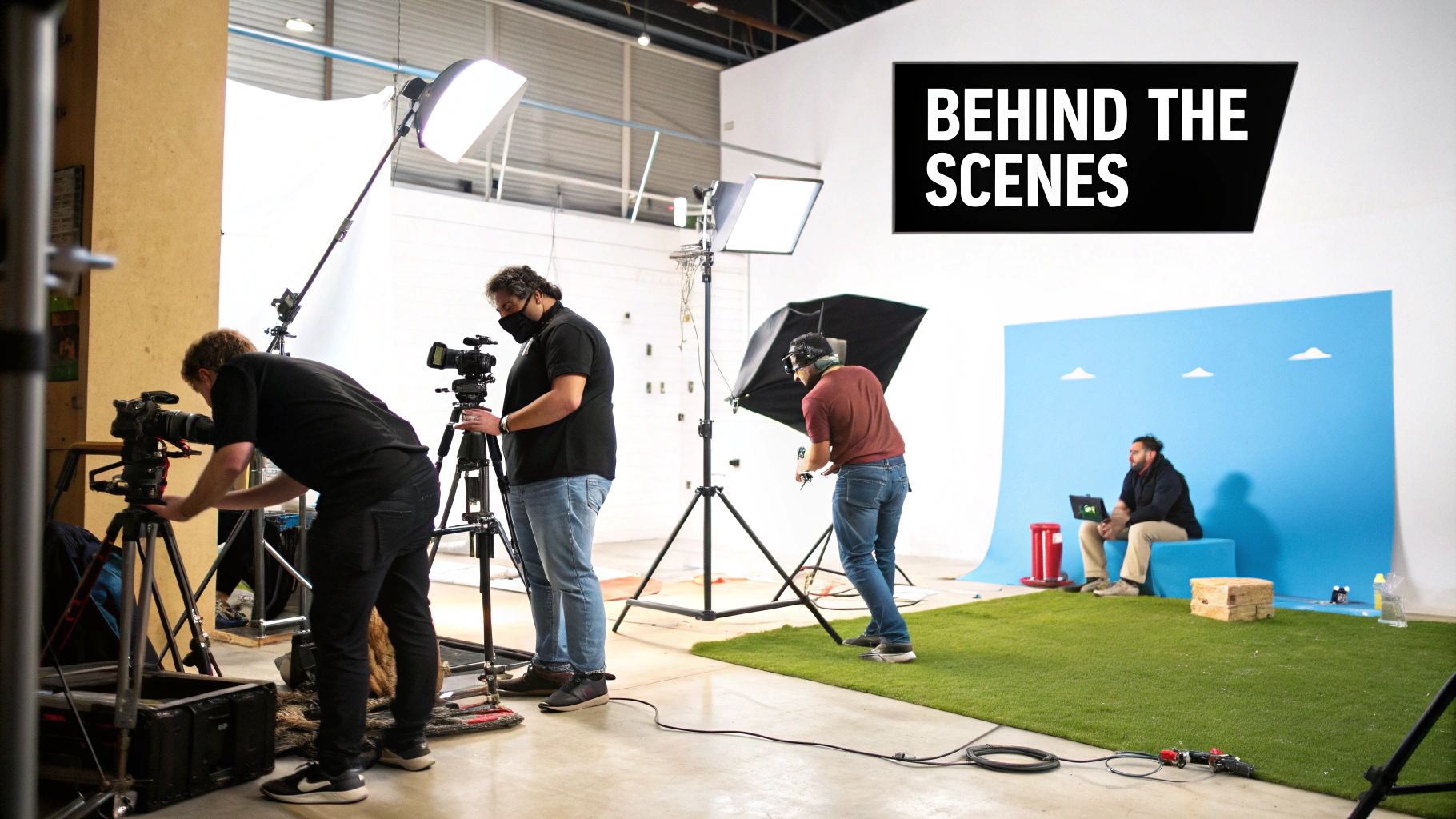Staring at a blank social media calendar is a universal challenge for marketers and creators alike. The relentless demand for fresh, engaging posts can quickly lead to content fatigue, forcing you to recycle the same tired formats and undermining your brand's momentum. What if you could access a renewable source of inspiration, moving beyond the panic of the daily post to build a truly strategic content pipeline? This comprehensive guide provides exactly that: a curated roundup of powerful, evergreen ideas for social media content designed to break creative blocks and fuel a sustainable, high-engagement strategy.
This is not a list of generic advice. Instead, you'll find actionable blueprints for ten distinct content types, from behind-the-scenes glimpses and user-generated content campaigns to interactive polls and timely trend-jacking. Each idea is crafted not just to fill a slot in your schedule, but to achieve specific marketing goals, whether that's building community trust, educating your audience, or driving direct sales. For practical application and inspiration, exploring successful campaigns can be incredibly insightful. Dive into these inspiring Facebook ad examples to see how different content angles perform in a paid context.
Ultimately, the goal is to transform your content workflow from a reactive chore into a strategic powerhouse that consistently delivers results. Get ready to explore a diverse mix of formats and themes that will resonate with your audience and keep your social media engine running at full capacity. Let's dive into the ideas that will help you connect, engage, and grow.
1. Behind-the-Scenes Content
Pulling back the curtain is one of the most powerful ideas for social media content because it builds trust and humanizes your brand. Behind-the-scenes (BTS) content offers your audience a raw, unfiltered glimpse into your company’s culture, processes, and the real people who make it all happen. This transparency demystifies your brand, transforming it from a faceless entity into a relatable group of individuals working toward a common goal.

This approach fosters a deep, authentic connection that polished marketing campaigns often miss. By showcasing the journey, not just the destination, you invite your followers into your world, making them feel like valued insiders.
Why It Works So Well
BTS content taps directly into human curiosity. People are naturally drawn to the "how" and "why" behind a product or service. Showing the messy, unscripted moments, the brainstorming sessions, or the intricate manufacturing process validates your brand's authenticity. This is particularly effective for building loyalty, as customers who feel connected to your brand’s story are more likely to become long-term advocates.
How to Implement Behind-the-Scenes Content
- Document Your Process: Use short-form video on Instagram Stories, Reels, or TikTok to show how a product is made, an order is packaged, or a service is delivered. Outdoor brand Patagonia excels at this by documenting its sustainable material sourcing and manufacturing.
- Spotlight Your Team: Introduce the people behind the brand. A simple Q&A with an employee, a "day in the life" takeover, or a team celebration post can significantly boost relatability and showcase your company culture.
- Show the "Before and After": This classic format is incredibly satisfying for viewers. Showcase the initial sketch of a design, the raw materials before assembly, or the first draft of a blog post next to the final, polished version.
- Create a Recurring Series: Establish a consistent BTS series to give your audience something to look forward to. Ideas include "Workshop Wednesdays," "Meet the Team Mondays," or a weekly "Office Tour" segment. This is a great way to generate ongoing social media content ideas.
2. User-Generated Content (UGC)
User-Generated Content (UGC) is one of the most powerful ideas for social media content because it transforms your audience into an active marketing force. It encompasses any content created by customers or fans, such as photos, videos, reviews, or testimonials, that features your brand. This strategy leverages authentic social proof, showcasing real people enjoying your products or services in genuine, relatable ways.

By curating and sharing UGC, you not only get a steady stream of diverse content but also build a strong sense of community. It shows your followers that you are listening and that you value their contributions, turning passive consumers into dedicated brand advocates.
Why It Works So Well
UGC is the digital equivalent of a word-of-mouth recommendation, which consumers trust far more than traditional advertising. It provides authentic, third-party validation that your brand delivers on its promises. When potential customers see people just like them using and loving your products, it eliminates skepticism and builds instant credibility. This peer-driven trust significantly influences purchasing decisions and fosters a loyal community around your brand.
How to Implement User-Generated Content
- Launch a Branded Hashtag Campaign: Create a unique, memorable hashtag and encourage your audience to use it when posting about your brand. GoPro’s campaigns, which feature breathtaking customer footage, have become a masterclass in using hashtags to source incredible UGC.
- Run Contests and Giveaways: Incentivize content creation by offering prizes for the best photo, video, or story. Starbucks' annual #RedCupContest generates massive engagement by encouraging customers to share their creative holiday cup photos.
- Feature Customers Prominently: Regularly spotlight customer content on your main feed, Stories, or even your website. Always ask for permission before reposting and give proper credit to the original creator to show your appreciation.
- Create Clear Guidelines: If you are seeking specific types of content, provide simple instructions. For example, a clothing brand might ask followers to share photos of them wearing an item in their favorite local spot, providing both UGC and location-based appeal.
3. Educational Content & Tutorials
Positioning your brand as a helpful expert is one of the most sustainable ideas for social media content. Educational content, such as tutorials and how-to guides, provides direct value to your audience by solving their problems, answering their questions, and teaching them valuable skills. This strategy builds authority and trust, making your brand the go-to resource in your niche.

Instead of just selling a product or service, you are empowering your community with knowledge. This selfless approach fosters loyalty and attracts a highly engaged audience that sees your brand as a credible partner in their journey, not just a vendor.
Why It Works So Well
Educational content directly addresses user intent and pain points. People constantly turn to social media and search engines for answers. By providing those answers, you capture high-intent users and establish a relationship built on value. This method excels at generating shares and saves, as users bookmark helpful information for later, extending your content's reach and lifespan significantly.
How to Implement Educational Content
- Solve Common Problems: Create content that answers your audience's most frequently asked questions. Use formats like short video tutorials, infographic carousels, or detailed blog posts. The design platform Canva does this masterfully with its quick tutorials on design principles and software features.
- Break Down Complex Topics: Take an intimidating subject in your industry and simplify it into a step-by-step guide. Use clear visuals, screenshots, and simple language to make it accessible to beginners.
- Create How-To Videos: Show, don't just tell. Short-form videos on TikTok or Reels are perfect for quick tips, while longer YouTube tutorials can offer a deep dive. Tasty's overhead recipe videos are a prime example of this format's viral potential.
- Offer Downloadable Resources: Enhance your tutorials with free templates, checklists, or e-books. This not only provides extra value but also serves as an excellent lead magnet to grow your email list. Marketing giant HubSpot built its empire on this very strategy.
4. Interactive Content (Polls, Quizzes, Q&A)
Interactive content transforms your social media feed from a one-way broadcast into a two-way conversation. By asking your audience to participate through polls, quizzes, and Q&A sessions, you make them active contributors to your brand’s narrative. This type of content is one of the most effective ideas for social media content because it directly boosts engagement metrics and provides invaluable audience insights.

Instead of just consuming information, followers become part of the experience. This active involvement strengthens their connection to your brand, making them feel heard and valued, which is a powerful driver for community building and loyalty.
Why It Works So Well
The core appeal of interactive content lies in its ability to satisfy the human need for expression and connection. When you ask a question, you give your audience a platform to share their opinions and see how they compare to others. Quizzes tap into our desire for self-discovery and entertainment, while live Q&A sessions offer direct, unmediated access to the people behind a brand, building immense trust and transparency.
How to Implement Interactive Content
- Leverage Platform Features: Use built-in tools like Instagram Stories polls, question stickers, and quizzes for quick, low-effort engagement. LinkedIn polls are excellent for gathering professional insights and starting industry-specific discussions.
- Host Regular Q&A Sessions: Dedicate a specific time for live Q&A on platforms like Instagram Live, Twitter Spaces, or Facebook Live. Promote the session in advance and encourage users to submit questions. Marketing expert Gary Vaynerchuk built a massive following by consistently hosting "AskGaryVee" sessions.
- Create Engaging Quizzes: Develop personality or knowledge quizzes related to your niche, similar to BuzzFeed's famous model. A skincare brand could create a "What's Your Skin Type?" quiz that guides users to the right products.
- Use Results for Follow-Up Content: Don't let the interaction end with a poll result. Share the outcomes in a subsequent post, analyze the findings, or create content based on the most popular answer. This shows you're listening and closes the feedback loop. This approach can also help you brainstorm new social media ideas for your content calendar.
5. Trending Topic Commentary & News Reactions
Injecting your brand into ongoing conversations is one of the most effective ideas for social media content to boost relevance and visibility. By reacting to industry news, viral moments, or trending topics, you position your brand as current, aware, and part of the cultural zeitgeist. This strategy showcases your expertise and personality, making your brand more dynamic and engaging.
This approach helps you capture the attention of a much wider audience beyond your existing followers. When done correctly, it demonstrates that your brand has its finger on the pulse, transforming you from a passive observer into an active participant in your community's discussions.
Why It Works So Well
Trending content leverages existing momentum. When a topic is already capturing widespread attention, social media algorithms prioritize it, giving your content a natural discoverability boost. Participating shows that your brand is agile and human. This is especially powerful for building a relatable persona, as seen with brands like Wendy's, whose witty commentary on trending events has become a core part of their identity.
How to Implement Trending Topic Commentary
- Move with Speed and Purpose: Timing is everything. The window of opportunity for a trending topic is often short. Use social listening tools and monitor news feeds to catch relevant stories early. Oreo's famous "You can still dunk in the dark" tweet during the 2013 Super Bowl blackout is a prime example of perfect timing.
- Add Value, Don't Just Report: Avoid simply restating the news. Offer a unique perspective, a thoughtful analysis, or a humorous take that aligns with your brand voice. A marketing expert might break down the implications of a new social media feature, adding genuine insight.
- Use Relevant Hashtags Strategically: Incorporate trending hashtags to join the conversation and make your content searchable. However, ensure the hashtag is genuinely relevant to your post and brand to avoid appearing opportunistic.
- Be Mindful and Authentic: Not every trend is right for your brand. Steer clear of sensitive or controversial topics unless they directly align with your core values and you are prepared to handle the response. Your reaction should always feel authentic, not forced.
6. Personal Stories & Brand Narratives
Storytelling is a fundamental human tradition, and leveraging it is one of the most effective ideas for social media content. Personal stories and brand narratives transform your marketing from transactional to relational by building deep emotional connections. This content shares your brand’s origin, highlights customer successes, and communicates the values that drive your mission.
By weaving narratives, you don't just sell a product; you invite your audience to become part of a larger story. This approach humanizes your brand, making it more memorable and relatable than a simple logo or slogan.
Why It Works So Well
Stories trigger an emotional response, making information more impactful and easier to recall. When an audience connects with a story, whether it's a founder's journey or a customer's triumph, they internalize the brand's values. This shared experience fosters a powerful sense of community and loyalty that goes far beyond customer satisfaction. Patagonia, for example, shares compelling stories of environmental activism, which resonates deeply with its audience and reinforces its brand identity.
How to Implement Personal Stories & Brand Narratives
- Share Your Origin Story: Detail the "why" behind your brand. What problem did you set out to solve? What challenges did you overcome? Use a carousel post or short video to tell this story in a compelling, chapter-by-chapter format.
- Spotlight Customer Transformations: Go beyond simple testimonials. Create in-depth case studies or video interviews that showcase a customer's journey from their initial problem to their successful outcome with your product. Airbnb excels at this by sharing heartwarming host and guest stories.
- Feature Employee Narratives: Humanize your team by sharing their personal stories and connections to the company's mission. This provides an authentic look inside your culture and values, which is key for effective brand building on social media.
- Focus on a Central Theme: Connect individual stories to a broader brand value, like sustainability, innovation, or community empowerment. This creates a cohesive narrative across your social media channels and reinforces what your brand stands for.
7. Product Showcases & Demonstrations
Moving beyond static images, product showcases and demonstrations bring your offerings to life, showing them in action to highlight their true value. This type of content focuses on demonstrating features, benefits, and real-world applications, helping potential customers visualize how a product or service can solve their problems or enhance their lives. It bridges the gap between seeing an item and understanding its utility.
This direct, value-driven approach is a cornerstone of effective social commerce. By clearly demonstrating what your product does and how it works, you answer customer questions proactively, build confidence, and significantly shorten the path to purchase, making it one of the most essential ideas for social media content.
Why It Works So Well
Demonstrations are inherently educational and persuasive. They appeal to an audience that has moved past initial awareness and is now in the consideration phase. Seeing a product used effectively removes doubt and showcases its benefits in a tangible way that a simple list of features cannot. Brands like Sephora master this by using makeup tutorials to not only demonstrate a product’s performance but also to inspire and educate their audience on new techniques.
How to Implement Product Showcases & Demonstrations
- Create "How-To" Video Guides: Produce short, engaging videos that show how to use your product to achieve a specific outcome. Home Depot’s DIY project demonstrations are a perfect example, as they naturally integrate tools and materials while providing genuine value.
- Focus on Benefits, Not Just Features: Frame your demonstrations around the problems your product solves. Instead of just showing a software feature, create a video that illustrates how that feature saves the user time or simplifies a complex task.
- Use High-Quality Visuals: Invest in professional-level photography and videography to make your products look their best. Apple is the benchmark here, using minimalist, crisp visuals that convey a sense of quality and sophistication.
- Showcase Real-World Scenarios: Place your product in a relatable, everyday context. A fashion brand can post "outfit of the day" reels showing how to style a garment, or a kitchenware company can film a recipe being made with its appliances.
8. Live Streaming & Real-Time Content
Broadcasting in real-time is a powerful way to generate buzz, urgency, and direct engagement. Live streaming content gives your audience an unfiltered, immediate connection to your brand, allowing for spontaneous interaction through live video, Q&As, and real-time commentary. This format creates a shared experience that feels exclusive and personal, cutting through the noise of pre-produced, polished content.
From major product launches on Facebook Live to casual Q&As on TikTok Live, this approach builds community by letting your audience participate in your brand's story as it unfolds. The unscripted nature of live content makes your brand appear more authentic, transparent, and accessible.
Why It Works So Well
Live content thrives on the "fear of missing out" (FOMO). Because it's happening now, followers are more inclined to tune in and participate. This immediacy creates an authentic dialogue, as brands can respond to comments and questions on the spot, making followers feel seen and heard. It’s one of the best ideas for social media content when you want to foster genuine community and drive high levels of engagement in a short period.
How to Implement Live Streaming & Real-Time Content
- Host Live Q&A Sessions: Invite your audience to ask you anything about your industry, products, or company. This is a simple yet highly effective way to provide value and build authority. Promote the session in advance to gather questions.
- Launch Products or Make Announcements: Build anticipation and share the excitement with your audience in real-time. A live launch event allows you to demonstrate features, answer immediate questions, and create a sense of occasion that pre-recorded videos can't match.
- Run Live Workshops or Tutorials: Teach your audience a new skill related to your niche. A fitness brand could host a live workout, while a software company could offer a live tutorial on a new feature. Remember that quality is key; a flawless stream depends on knowing how to sync audio with video for a professional user experience.
- Go Live Spontaneously: While planned events are great, spontaneous streams from an event, a team meeting, or just a quick office update can feel even more authentic. These impromptu sessions are excellent for platforms like Instagram and TikTok. You can further explore this video-centric strategy by learning more about how to use YouTube to market your website.
9. Memes & Humorous Content
Using humor is one of the most effective ideas for social media content because it breaks down barriers and makes your brand instantly more human and shareable. Memes and humorous content tap into current internet culture, offering a lighthearted way to connect with your audience on their level. Instead of a hard sell, you’re providing entertainment, which builds positive brand association and encourages organic reach.
This strategy transforms your brand from a corporate entity into a relatable friend who understands the "inside jokes" of the internet. By participating in these conversations, you make your brand part of your audience’s community, fostering engagement that feels natural rather than forced.
Why It Works So Well
Humor and memes are the native language of the internet. They are highly shareable, have the potential to go viral, and can communicate a complex feeling or situation in a single image. This type of content works because it elicits an immediate emotional response, making your brand memorable. When a follower laughs, they are more likely to like, comment, and share, significantly boosting your content's visibility and engagement metrics.
How to Implement Memes & Humorous Content
- Tap into Relevant Meme Formats: Stay current with what’s trending on platforms like TikTok and Twitter. Adapt popular meme formats to fit a niche pain point or experience relevant to your audience. Brands like Slim Jim excel at this by consistently using chaotic, on-trend humor that resonates with their target demographic.
- Develop a Unique Brand Persona: Your humor should align with your brand voice. Wendy's is famous for its sarcastic and witty Twitter persona, while Duolingo's unhinged owl on TikTok has become a cultural phenomenon. Define your brand's sense of humor and apply it consistently.
- Create Relatable, Niche Humor: You don't always need to use a trending meme. Create original, funny content based on universal truths or struggles within your industry. This shows a deep understanding of your audience and positions you as an insider.
- Balance Humor with Value: While funny content is great for engagement, it shouldn't be your only strategy. Mix in your other valuable social media content ideas to ensure your profile remains informative and authoritative. The goal is to entertain, not to become a full-time comedian.
10. Collaborative Content & Partnerships
Collaborating with other brands, influencers, or industry experts is one of the most effective ideas for social media content because it taps into the power of shared audiences. This strategy involves creating content jointly with a partner, such as a co-hosted webinar, an influencer takeover, or a cross-promotional campaign. The core principle is leveraging another entity's credibility and reach to introduce your brand to a new, yet relevant, audience.
These partnerships act as a powerful form of social proof. When a trusted creator or complementary brand co-signs your product or service, their audience is far more likely to engage with and trust you. It’s a strategic alliance that generates fresh content while rapidly expanding your brand's footprint.
Why It Works So Well
Partnerships work by borrowing trust and authority. An endorsement from a respected figure in your niche can do more for brand perception than a dozen paid ads. This approach also combats content fatigue by introducing new faces, voices, and perspectives to your feed. It’s a symbiotic relationship: you gain access to a new audience and valuable content, while your partner receives similar benefits, creating a win-win scenario that provides immense value to both communities.
How to Implement Collaborative Content & Partnerships
- Identify Strategic Partners: Look for influencers, creators, or non-competing brands whose audience demographics and brand values align with yours. Tools like Upfluence or a simple search on relevant hashtags can help you find potential collaborators.
- Co-Create Valuable Content: Don't just settle for a simple shoutout. Develop content that genuinely benefits both audiences, such as a joint live session on Instagram, a collaborative article on LinkedIn, or a detailed tutorial video on YouTube. For instance, a fitness apparel brand could partner with a nutritionist for a Q&A on healthy eating.
- Run Cross-Promotional Giveaways: Host a joint contest or giveaway where participants must follow both accounts to enter. This is a classic and highly effective tactic for rapidly growing your follower count with an engaged audience.
- Launch an Influencer Takeover: Allow a trusted influencer to take over your social media account for a day. This provides your audience with fresh, authentic content while giving the influencer's followers a reason to check out your page. Ensure clear guidelines are set beforehand.
Top 10 Social Media Content Ideas Comparison
| Content Type | Implementation Complexity 🔄 | Resource Requirements ⚡ | Expected Outcomes 📊 | Ideal Use Cases 💡 | Key Advantages ⭐ |
|---|---|---|---|---|---|
| Behind-the-Scenes Content | Medium – Requires consistent documentation | Low – Typically low-cost, some time-based | Builds trust, authenticity, emotional connection | Brands wanting transparency and audience engagement | Authenticity, engagement, cost-effective |
| User-Generated Content (UGC) | Low to Medium – Requires community management | Low – Depends on community size | Increases trust, extends reach, provides social proof | Brands leveraging audience creativity and advocacy | Authentic social proof, cost-effective, reach expansion |
| Educational Content & Tutorials | High – Requires research and quality production | Medium to High – Time and expertise needed | Builds authority, generates leads, improves SEO | Brands positioning as industry experts | Authority building, long-term value, lead generation |
| Interactive Content (Polls, Quizzes, Q&A) | Medium – Needs setup and real-time engagement | Medium – Requires active monitoring | Boosts engagement, gathers insights, drives interaction | Brands seeking active audience participation | Engagement boost, direct feedback, content guidance |
| Trending Topic Commentary & News Reactions | High – Requires rapid content creation and monitoring | Medium – Time-sensitive and reactive | Increases visibility, viral potential, builds thought leadership | Brands wanting relevance and trend engagement | Timely relevance, viral reach, thought leadership |
| Personal Stories & Brand Narratives | Medium – Story crafting can be time-intensive | Low to Medium – Mainly creative effort | Creates emotional connection, builds loyalty | Brands sharing authentic experiences and values | Emotional resonance, shareability, loyalty |
| Product Showcases & Demonstrations | Medium to High – Needs high-quality visuals | Medium to High – Professional production | Drives sales, reduces support queries, showcases product value | Brands promoting features and benefits of products | Sales-driven, visual appeal, customer education |
| Live Streaming & Real-Time Content | High – Demands confidence, schedule, and tech | Low to Medium – Mostly time and setup | High engagement, authentic connections, builds community | Brands wanting real-time interaction and exclusivity | Authenticity, engagement, cost-effective |
| Memes & Humorous Content | Low – Quick to produce but needs cultural insight | Low – Mainly creative and timely effort | High shareability and engagement, builds relatability | Brands using humor to connect and entertain | Virality, relatability, shareability |
| Collaborative Content & Partnerships | Medium to High – Coordination between parties | Medium to High – Depends on partners | Expands reach, diversifies content, builds credibility | Brands expanding audience and co-creating | Reach expansion, credibility, content diversity |
Automate Your Evergreen Ideas for Lasting Impact
We've explored a comprehensive arsenal of ten powerful categories of ideas for social media content, from the authenticity of behind-the-scenes glimpses to the community-building power of user-generated content. You now have a strategic blueprint to move beyond generic posts and cultivate a social media presence that is dynamic, engaging, and genuinely valuable to your audience. The journey from a blank content calendar to a vibrant, thriving feed is no longer a mystery.
The core takeaway is this: variety and value are your greatest assets. A successful social media strategy doesn't rely on a single type of content. It masterfully blends educational tutorials, interactive polls, personal brand stories, and timely humor to create a multi-faceted brand personality that resonates with different audience segments. Each idea, from a product deep-dive to a collaborative live stream, serves a unique purpose in the ecosystem of your digital presence.
From Inspiration to Implementation
The true challenge for marketers and business owners isn't a lack of ideas; it's the execution. Consistently creating and scheduling high-quality content is a demanding task that can quickly lead to burnout. This is where the concept of an "evergreen content engine" becomes a game-changer. Many of the content formats we discussed, such as tutorials, team spotlights, brand origin stories, and top-performing UGC, are not one-off posts. They are timeless assets.
Think of your best content not as a disposable firework but as a perennial plant that can bloom again and again. By systematizing these assets, you transform your past efforts into a sustainable source of future engagement. This strategic shift moves you from a reactive content creator, constantly chasing the next post, to a proactive architect of your brand's narrative.
Building Your Automated Content Engine
The key to unlocking this efficiency is automation. Instead of letting your best work get buried in your feed, you can build a system that continuously resurfaces it for new and existing followers to discover. This ensures your profiles remain active, your key messages are consistently reinforced, and you maximize the return on your initial content creation investment.
Here’s a practical path forward to put these ideas for social media content into a sustainable, automated workflow:
- Audit Your Assets: Review your existing content and identify your top-performing evergreen pieces. Look for posts with high engagement, educational value, or strong brand messaging.
- Create Content Buckets: Categorize these assets into logical themes, just like the sections in this article. You might have buckets for "Educational Tips," "Brand Stories," "Product Demos," and "Customer Testimonials."
- Implement an Automation Tool: Use a platform designed specifically for evergreen content automation. This allows you to fill your categorized buckets and let the tool manage the scheduling and posting for you.
- Analyze and Refine: Continuously monitor the performance of your automated posts. Remove underperforming content and add new, successful pieces to your buckets to keep the engine running with fresh, high-impact material.
By embracing this model, you ensure that even during your busiest weeks, your social media channels are powered by a steady stream of proven, high-value content. This frees up your time and mental energy to focus on real-time engagement, community management, and developing new, creative campaign ideas. You're no longer just posting; you're building a long-term strategic asset that works for you around the clock.
Ready to turn your best ideas for social media content into an automated, evergreen powerhouse? EvergreenFeed is designed to do just that, letting you create content buckets and automatically recycle your best posts to keep your social media queues full and engaging. Stop manual scheduling and start building a lasting content engine by visiting EvergreenFeed today.




